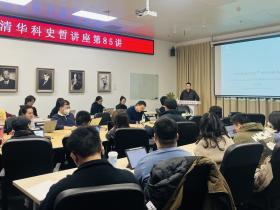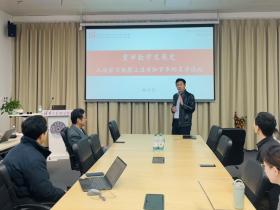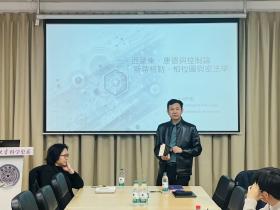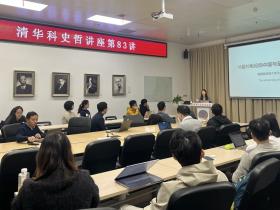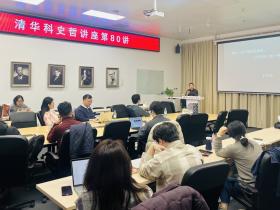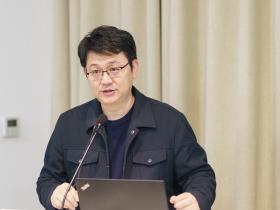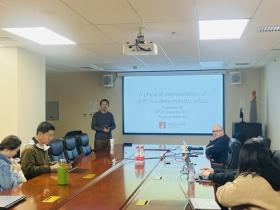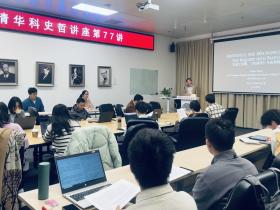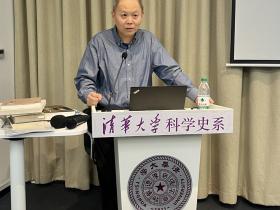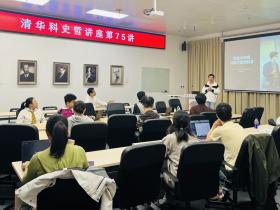On the afternoon of June 14, 2024, the Department of History of Science of Tsinghua University held the 67th Lecture of theTHU History and Philosophy of Science Lecture Series. The guest speaker was Liu Mengyao, a Ph.D. candidate in the Department of Classics at Stanford University, whose lecture was titled “Orator Patiens — The Medical Application of Rhetoric in Aelius Aristides’ Hieroi Logoi.” The event was chaired by Assistant Professor Lu Bolin of the Department of the History of Science, with nearly twenty faculty members, students, and scholars attending in person.

Liu Mengyao began by introducing the life of Aelius Aristides, a second-century CE Greek orator in the Roman Empire. At age 26, after mastering rhetoric in the Mediterranean world, Aristides intended to pursue his career in Rome but fell seriously ill en route. Despite seeking treatment from doctors in Rome and his hometown, he failed to recover and was forced to abandon his ambitions. He then underwent a two-year incubation therapy at the Asclepieion of Pergamon, a temple dedicated to the healing god Asclepius. This religious healing practice required patients to sleep in designated areas and have their dreams interpreted by priests as medical prescriptions—such as fasting, bloodletting, exercise, or specific ointments. Aristides, who struggled with chronic illness throughout his life, embraced dual identities as both a patient and an orator. After regaining his health through temple therapy, he composed six speeches collectively known as Hieroi Logoi (Sacred Tales) as offerings to Asclepius. These texts exemplify the intertwined relationship between religion and medicine in the ancient Greek world, where temple medicine and secular medicine coexisted in both competition and collaboration.
In the prologue of the first speech, Aristides explicitly states his intent to recount how the god healed him. However, from the fourth speech onward, after detailing his improved health post-therapy, he shifts focus to his career as an orator, describing his travels and rhetorical performances. To explain the structural unity of Hieroi Logoi, Liu proposed the concept of “rhetorical therapy.” She argued that Aristides’ rhetorical exercises were not merely professional endeavors but integral to his healing process, serving as therapeutic practices during his recovery at the temple.

To support this argument, Liu presented three lines of evidence:
First, five major medical thinkers from Hippocrates onward provided the conceptual framework, physiological basis, and practical principles for rhetorical therapy. Hippocrates’ regimen theory, grounded in the doctrine of the four humors (dry, wet, hot, cold), categorized health practices into exercise and diet. Vocal exercises like speaking, reading, and singing were classified as “natural exercise” for stimulating the soul. By the first century BCE, Celsus recommended loud reading followed by walking and upper-body movement to treat gastric disorders. Soranus advocated reading and walking for patient rehabilitation and even suggested rhetorical therapy for improving lactation in pregnant women. Antyllus formalized these practices as Anaphonesis (“voice modulation exercises”), while Galen integrated humoral theory with anatomical knowledge, advancing rhetorical therapy further. Liu defined rhetorical therapy in Aristides’ era as a method to enhance health through structured rhetorical practice.
Second, Aristides’ Hieroi Logoi explicitly links his rhetorical exercises to his physical condition. He emphasizes the intensity and difficulty of these practices, crediting divine assistance for completing them, and notes immediate health improvements when following divine instructions.
Third, Galen directly commented on Aristides’ ailments. As a physician, Galen adhered to Plato’s belief that health depended on balancing the soul and body. He argued that vigorous rhetorical exercises could exacerbate illnesses in individuals with a strong soul but weak body (like Aristides), advocating gentler activities like poetry or meditation instead.
Since the 1990s, historians of science—particularly scholars of antiquity—have reexamined ancient disciplinary boundaries. Following thinkers like Canguilhem and Foucault, medical historians now emphasize patient-centered perspectives in historical practice. Liu highlighted the uniqueness of Hieroi Logoi as a first-person account by an elite patient with medical knowledge and religious authority, allowing him to challenge physicians’ expertise.
During the Q&A session, faculty members and students, including Professor Liu Xiao, Assistant Professor Lu Bolin, and students Huang Zongbei and Liao Yuqing, engaged in lively discussions on topics such as the terminology of “rhetorical therapy,” the concept of “wetness” in humoral theory, comparisons with traditional Chinese medicine, and practical details of rhetorical therapy.


